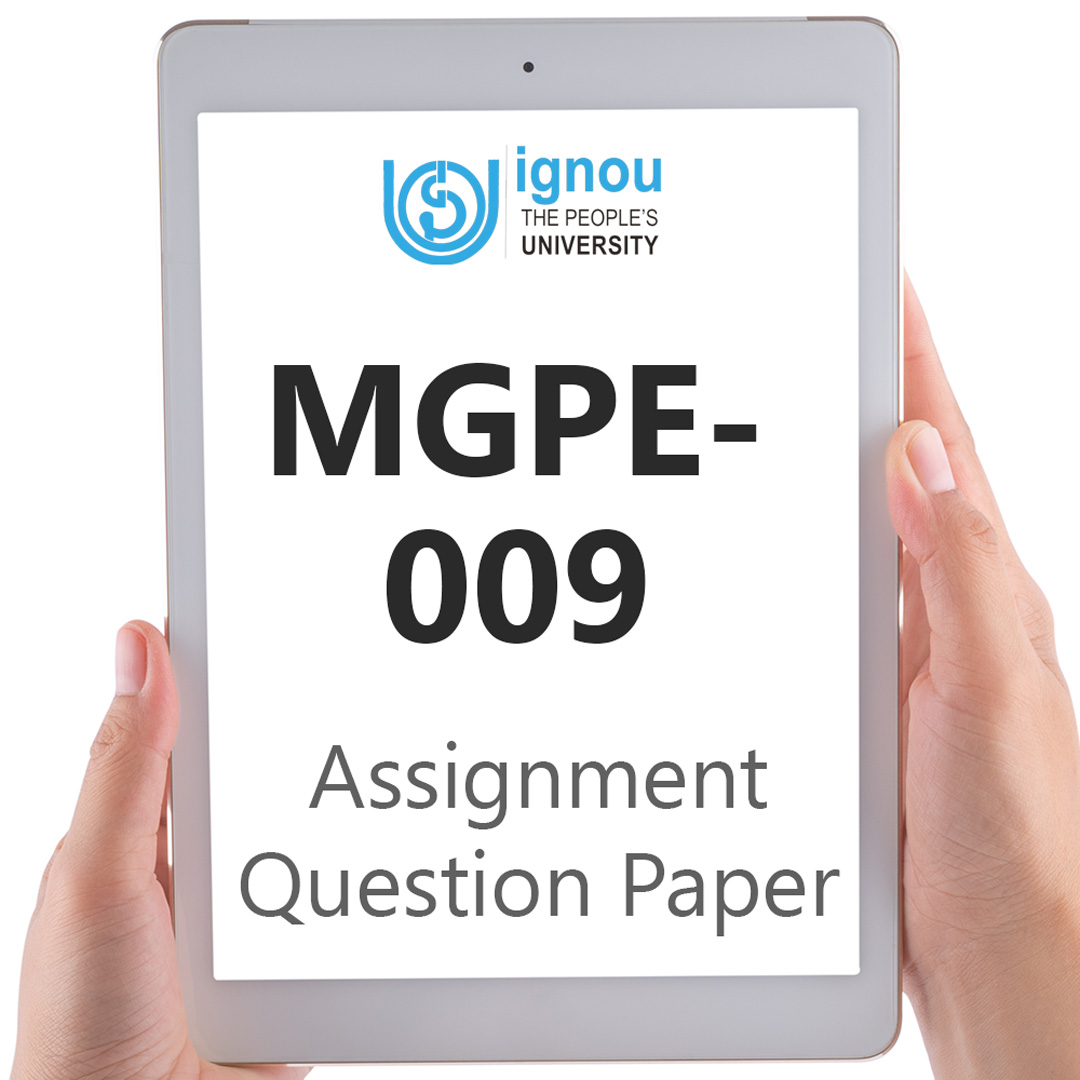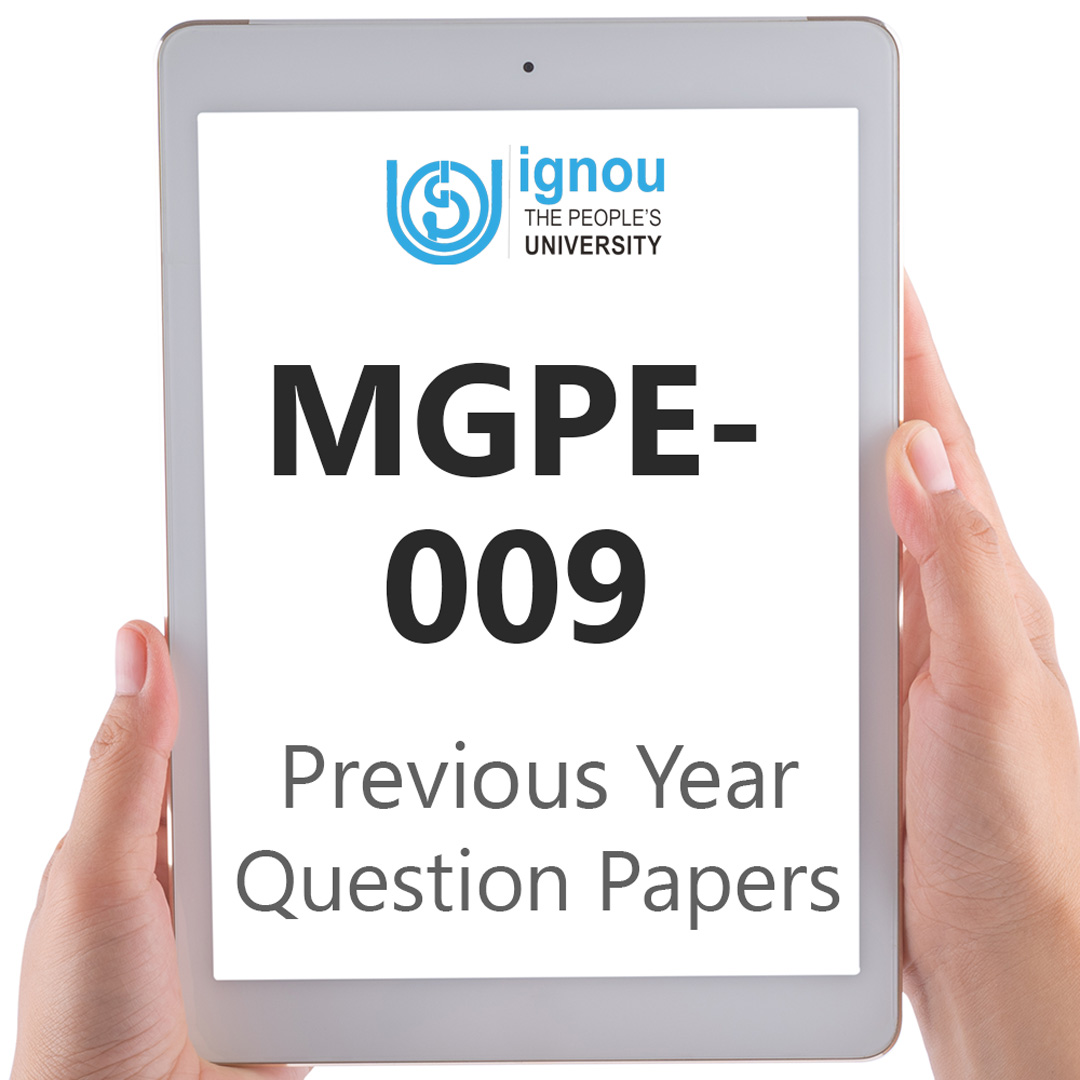If you are looking for MGPE-009 IGNOU Solved Assignment solution for the subject Gandhi in the 21st Century, you have come to the right place. MGPE-009 solution on this page applies to 2022-23 session students studying in MGPS, PGDGPS courses of IGNOU.
MGPE-009 Solved Assignment Solution by Gyaniversity
Assignment Code: MGPE-009/ASST/TMA/2022-23
Course Code: MGPE-009
Assignment Name: Gandhi in the 21st Century
Year: 2022-2023
Verification Status:Verified by Professor
Answer five questions in all, selecting at least two questions from each section. Each question is to be answered in about 500 words. Each question carries 20 marks.
Section-I
Q1) What are the effects of globalisation in the context of India?
Ans) The international community recognises globalization's risks to regional and national identities but has prioritised tolerance and acceptance through multicultural policy. Globalization can harm national and local identities; it says in one of the Human Development Reports. Multicultural policies that promote variety and pluralism are the answer, not a return to conservatism and isolationist nationalism; nevertheless, it is unclear how this goal can be accomplished within the framework of the same policy and politics that have led to their demise.
There needs to be research into an alternate development paradigm that may lead to these outcomes. Capital values have been universalized and a uniform political system has been created as a result of globalisation, both of which require strong social and cultural foundations to survive. The capitalist path of development and the communist experiment are the two main currents of development practise around the world. Despite its lofty claims, the former is dying due to internal contradictions such as stagnation, deflation, unemployment, poverty, and now global financial crises. On the other hand, communist practises, which collapsed in the Soviet Union despite having provided almost full employment for nearly seven decades and still exist in many countries with higher growth rates, are thriving in many countries with lower growth rates.
Among many potential examples, China and Vietnam stand out. The nominal movement in India's mixed economy, which had a Gandhian undertone and a socialist touch, has faded. All egalitarian undertones in India's development processes have been replaced by a market-oriented approach. An interesting fact about globalisation is that the United Nations has acknowledged nonviolence as a safety valve. Gandhi saw the polity as an oceanic circle, in which everyone is connected but no one is dependent on anybody else. His worldview was encapsulated by the phrase, "Independence must begin at the bottom. This means that every community can function as a sovereign republic, or Panchayat.
Each community must be self-sufficient, from providing for its own needs to protecting itself from outside threats. Accordingly, the person is the fundamental building block of society. Having to rely on and accept assistance from one's community and the wider world is not negated by this. Forces will interact with one another in a very open and friendly manner. A highly cultured society, in which every man and woman knows what they want and, more importantly, realises that they shouldn't want anything that other people can get for the same amount of work.
All the settlements that make up this massive structure will expand outward in a never-ending spiral. The peak of your life won't have to rely on the base to keep it up. But it will be an oceanic circle with the individual at its centre, ready to die for the village and the village ready to die for the circle of villages, until at last the whole becomes one life made up of individuals, never aggressive in their arrogance but always humble, sharing the majesty of the oceanic circle of which they are integral units. As a result, the outermost rim will not use its strength to crush the inner circle, but rather will provide support for those closer to it and draw its own energy from the core.
Q2) What is liberal democracy? Identify its features.
Ans) Liberal democracy was the ancestor of modern representative democracy. A secular and national system of power characterised by defined territory, control of the means of violence, an impersonal power structure, and legitimacy was made possible by the development of the liberal state, which emerged from the ashes of absolutism in the late 17th century. These two revolutions the English and the French marked the beginning of a shift away from absolute monarchies and toward contemporary state systems whose governments draw their legitimacy and consent from the people.
The two notions that make up liberal democracy are "liberal," which refers to restraints on government, and "democratic," which refers to popular sovereignty, political involvement, and representative government. In a nutshell, liberalism means "freeing the people," while democracy means "empowering people"; demos-protection means "safeguarding the people from tyranny and arbitrariness," while demos-power means "implementing popular rule," to use Sartori's terminology. Prior to its transformation into a democratic state, the liberal state was constrained by the constitution.
Marxists and Elitists are two groups that have been critical of traditional liberal democratic thought. The latter emphasise that it is the elite, rather than the masses, who dominate in every community. Pareto argues that the elite are successful for psychological reasons, whereas Mosca and Michels credit their success to their ability to organise and Burnham credits it to their mastery of technology. Schumpeter argues that democracy and elitism are compatible. He argues that the classical theory's claim to know the will of the people, based on the assumption that people are homogenous, is an impossible requirement to meet, given that every society has a plurality of conflicting wills. The idea that it requires an exceptionally logical mind is another common misconception.
Marxist Democracy is both a critique of liberal democracy and an alternative to it. Liberal democracy's formal definition of equality is criticised because, without economic equality, which is a result of private property, political equality would be a farce. Private property and capitalism must be eliminated for rule by the people, the non-propertied, to materialise as a system of government. It could happen if the working class, the real source of wealth, were to topple capitalism and establish an alternative system, socialist democracy. Marx and Engels advocate for a proletariat-led socialist revolution in which the working-class gains power and democracy as a result.
As a system of government based on competitive elites, democracy draws parallels between market and governmental behaviour. Pluralists believe that the modern liberal state is too complicated for any one group, class, or organisation to rule over the others. For the many factions that reflect society's disparate, dominant interests, politics provides a forum for finding common ground and negotiating solutions to their conflicts. Minority rule, or dictatorship, is not the same thing as majority rule, or democracy. Consensus on the rules of procedure, the spectrum of policy possibilities, and the permissible scope of political activity are preconditions for a functioning polyarchy, which acts as a deterrent against authoritarian rule.
Q3) What are the views of Gandhi on religion? What did religion mean to him?
Ans) Gandhi thought religion should bring people together, not drive them apart. Gandhi's deepest connection to Hinduism and the Gita, which he termed his "spiritual dictionary," were the two things that most shaped his life and philosophy. His life was profoundly impacted by two concepts he first encountered in the Gita: aparigraha and samabhava. Though Gandhi's religious thought had its roots in Hinduism, it was profoundly humanist and international because of his strong intellectual and sceptical streak. The transcendent actuality of God, the unity of all life, and the value of ahimsa as a way of discovering God encapsulated Gandhi's Hinduism.
After doing a thorough study of religions during his time in South Africa, Gandhi was struck by the fundamental similarity between all faiths. He never stopped stressing the importance of religious tolerance and mutual respect after that. There are many diverse faiths, yet ultimately they are all the same at their core, or "trunk." The names God, Allah, Rama, Narayan, Narayani, Ishwar, and Khuda all referred to the same Ultimate Reality. When people waited on God, regardless of their ethnic background, God's grace and revelation showered down on them. He believed that there was no perfect faith. We may either say that everyone is equally flawed or that everyone is equally perfect.
In his 1927 article "Why I am a Hindu," Gandhi explained that he had found Hinduism to be the most tolerant of all religions. Its lack of dogma allows the adherent the most possible latitude for personal expression. Because it is not exclusive, its adherents are able to not only tolerate but also appreciate and adopt the best aspects of other faiths. Although the concept of nonviolence can be found in other faiths, it is most fully developed and practised in Hinduism. That all life, not just human life, is sacred to the Hindu gods is central to the religion's philosophy. Despite his emphasis on the importance of each person's own judgement and conscience, he also emphasised tolerance and peaceful cohabitation with those of different faiths.
Gandhi held that no one should be denied the freedom to follow their personal religious beliefs, and that the government had no business imposing its own religious standards on its citizens. He was a devout Hindu who thought all religions were just various roads that led to the same destination: the Truth. All faiths share a common religious foundation. Gandhi believed that Truth is superior to everything, and that anything that contradicts it must be rejected, even the teachings of other religions if they contradicted Gandhi's nonviolent stance. What is incompatible with Reason must also be rejected.
Gandhi was a deeply religious man because he was devoted to this quest for truth, which he believed to be the ultimate religion. He was a man whose mind and life were equally influenced by experimentation and religion. Throughout the course of the fight for independence, he consistently exhibited the combination of religious piety and a modern humanistic attitude that ultimately gained him the favour of the public. He persistently advocated for a rapprochement between Hinduism, Islam, Sikhism, and Christianity around the shared belief that there is just one, absolute Truth.
Section-II
Write a short note on each part of the question in about 250 words:
Q1) (a) India and its cultural diversity
Ans) There are very few nations in the world that do not exhibit cultural diversity. India is one of the most culturally varied societies in the world, and its size makes it the largest multicultural nation in the world. Its large population is made up of followers of all the world's main religions, including Hindus, Muslims, Christians, Sikhs, Buddhists, Jains, and Zoroastrians. India is home to the second-largest Muslim population in the world, despite the fact that Hindus make up the bulk of the country's population. Along with the diversity, there is a huge cultural diversity based on things like language, caste, and ethnicity.
There are 114 spoken languages in this country, and 22 of them are spoken by more over one million people, according to the 1991 Census. 630 communities are listed by the state as Scheduled Tribes. Even within these groups, there is variability, and many of the communities that have been identified are thought to be internally heterogeneous, consisting of a number of smaller, distinct tribes. The country has a wide range of religious and cultural diversity. When India gained independence in 1947, the political elite and those who drafted the Constitution took into consideration this diversity as they deliberated on a framework that would allow for an integrated yet culturally diverse nation-state that is based on the principle of unity in diversity.
The pre-independence era's history is a key component of the multi-religious and multicultural nature of Indian society. The nation's culturally diverse people were intended to be brought together by the Independence struggle against a colonial authority to work toward a nationalist objective. It was a fight for national identity; it aimed to bring together people from different religious and cultural backgrounds under a nationalist banner. Although many culturally varied groups gradually united on a nationalist platform throughout the nationalist fight, there arose stark disparities between Hindus and Muslims that were increasingly portrayed as antagonistic.
Q1) (b) Gandhi’s Gram Swaraj and its relevance today
Ans) Swaraj typically refers to self-government or home rule. It places emphasis on self-governance through individuals and community building rather than hierarchical government. Gandhi saw it vital to develop a method to accomplish the twin goals of empowering the people and the state because decentralisation was the main focus. He created the twin-pronged strategy of resistance and reconstruction in response to this. Even though the word "Swaraj" refers to self-rule, Gandhi gave it the meaning of a revolutionary internal movement that affects all aspects of life.
At the personal level, swaraj is inextricably linked with the capacity for objective self-evaluation, ongoing self-purification, and increasing self-reliance. Politically speaking, swaraj is self-government and denotes a constant attempt to be free of governmental authority, whether it be national or international. Swaraj refers to complete economic independence for the labouring masses. Gandhi engaged in a variety of positive initiatives aimed at lessening Indians' reliance on the British while also fostering their independence because swaraj could not be achieved without the abolition of all forms of dominance.
Gandhi's Gram Swaraj was the creation of new, independent groups of villages with a self-sufficient economy rather than the revival of the old village. He outlined the political and economic relationships that the community should have in detail. Man was preeminent in his eyes. Human happiness mixed with complete intellectual and moral development is the goal to be pursued. One of the essential requirements for the rehabilitation of Gandhian villages was self-sufficiency in terms of basic needs. The production of food, clothing, and other essentials at the village level alone would result in full employment and practically full employment of everyone who is able-bodied, preventing rural-to-urban migration in pursuit of employment and better possibilities.
Q2) (a) Gandhi’s views on science and technology
Ans) Gandhi had strong opinions against the exploitation of science and technology, whether it be for the creation of weaponry, vivisection, or machines. He said, "Modern civilization has forgotten that its greatest achievements are weapons of mass destruction, the terrible growth of anarchism, the dreadful conflicts between capital and labour, and the wanton and diabolical cruelty inflicted on innocent, dumb, living animals in the name of science, falsely so called. Modern civilization, far from having done the greatest good to humanity. Even while they are obviously excellent in and of themselves, the claim about the marvellous discoveries and marvellous marvels of science is ultimately a hollow one.
Gandhi firmly responded: "Scientists to be worth the name should reject such a state unto death." Gandhi was asked by a scientist what scientists should do if the Indian government requested them to conduct research to further war and the atomic bomb. Gandhi was vehemently opposed to procedures used by contemporary scientists, such as vivisection. According to him, vivisection is the most heinous act that man is now performing against God and his good creation. If the cost of living is the suffering of living things, we should have the option to choose not to live.
Through the use of extremely complex machinery, industrialization enables mass production, which refers to manufacturing by the fewest number of people possible. Gandhi intended mass manufacturing when he used the term. He questioned, "Would it not provide you mass production on a vast scale if you multiplied individual production by a million times?" Gandhi argued that he was only opposed to mass manufacture of goods that people could easily produce. He argued that using a machine to do something that millions of unoccupied hands might do just as easily is detrimental. Mechanisation is useful when the hands are insufficient for the intended work to be completed, he stated. When there are more workers than are necessary for the job, as in India, it is a bad thing.
Q2) (b) Gandhi’s views on Human Rights and Duties
Ans) Gandhiji stood for love, universal brotherhood, freedom, justice and equality to him. Service to community, is service to God. Human rights are said to be those fundamental rights which every man or woman inhabiting any part of the world should be entitled to by virtue of having been born as a human being.
Beginning in the early 1900s, Mahatma Gandhi became active in the public eye by advocating for human rights in South Africa. Abolishing untouchability, promoting Hindu-Muslim unity and harmony, popularising the use of khadi, supporting prohibition, the panchayat system and cottage/village industries, village sanitation, upliftment of the underprivileged, and many other political and social movements occupied his entire political life after his return to India from South Africa.
In short, his life's work and aim were to advance the rights and responsibilities of every member of society. Gandhi's views on human rights are not appropriate topics for discussion in this unit. Gandhi, though, was a lot ahead of his time, and that should be acknowledged. In contrast to Gandhi, who had been working for human rights for more than 50 years prior to the publication of this historic Declaration, human rights were only placed on the national and worldwide agenda after the Universal Declaration of Human Rights was adopted in December 1948.





